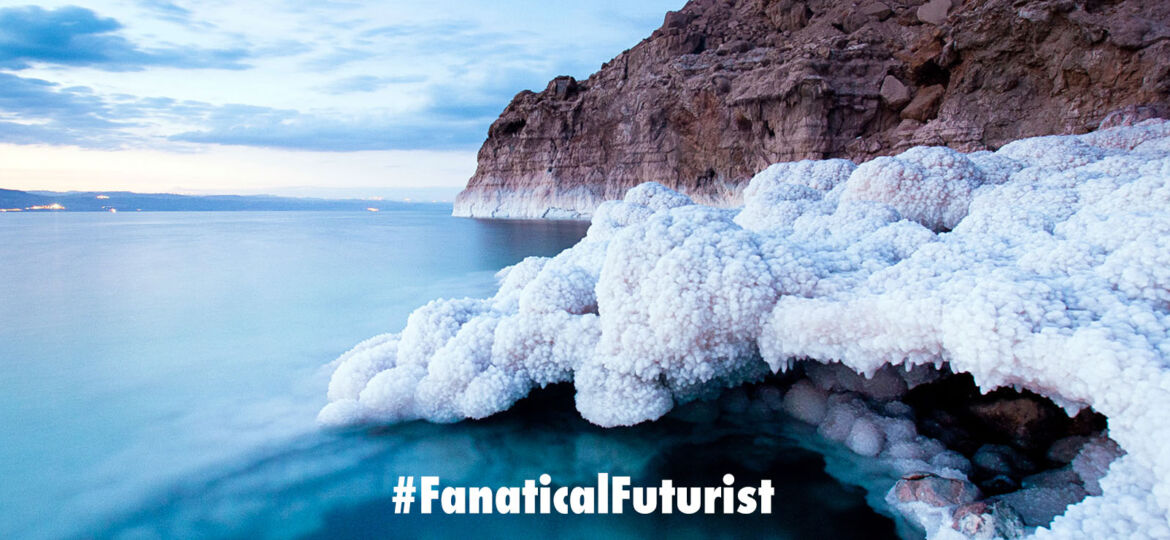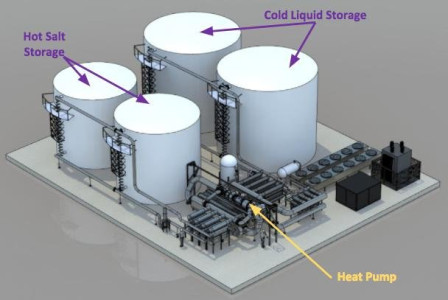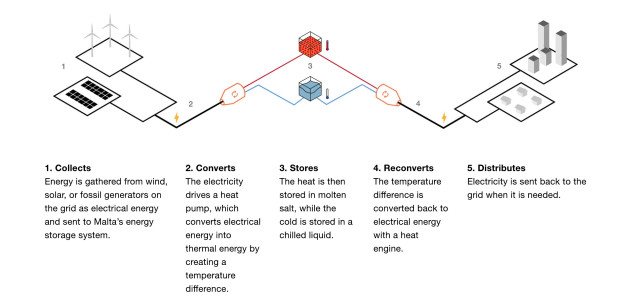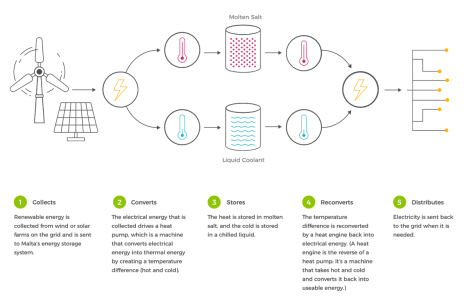
WHY THIS MATTERS IN BRIEF
Renewable energy sources only generate electricity when the sun shines or the wind blows, so companies have to find a way to store it so it can be used in times of scarcity.
One of the biggest problems with renewable energy is that when the sun stops shining, and the wind stops blowing, they stop producing energy so it’s vital to the future of green energy production that any excess electricity generated by these systems, when the sun is shining and wind is blowing, can be stored so it can be released as needed to the grid when energy supply is low. X, the division of Google that focuses on so-called moonshot programs, is one of the companies that has been working for several years now to produce a low cost, grid scale energy storage system that uses molten salt that could solve this problem and the initiative, called Malta, has now been spun off into a separate standalone business.
Molten salt is the core technology behind many concentrated solar power installations. In simple terms, such systems use the heat the sun’s rays to create and store it for use later. Such “time shifting” as it’s known is essential if we’re ever going to wean ourselves off of fossil fuels.
“At X we support our projects through the early stage prototyping and de-risking of their ideas, and then we help them find whatever business path or structure works best for the type of problem they’re working on,” a company spokesperson says. “In Malta’s case, we’re looking forward to cheering them on as an independent company focused on developing an affordable and reliable way to store renewable energy — something that requires partners with very specialized skills and expertise.”
While it was part of X, the Project Malta team explored a number of designs and prototypes. It also worked with utility companies and grid operators to better understand how energy storage fits into the overall goal of providing electricity when and where it is needed.
According to 9to5Google, the Malta system can store energy for more than 6 hours and can be charged thousands of times before its performance begins to degrade, giving it an estimated service life of more than 20 years. The heat stored in the molten salt can be converted back to electricity on an as-needed basis at any time, and as reported by Renewable Energy News, the Malta energy storage project is based on research done by Robert Laughlin, a Nobel prize-winning physicist. He met X representatives at a conference a few years ago where they discussed the idea. Laughlin then became a consultant for the project, which consisted of a team of 10 engineers, and has endorsed the designs the Malta team has created.
The thermodynamics of the system are well known. What Malta has done is take the esoteric and costly components usually needed to make such a system work and replaced them with conventional materials that are much less expensive. The key is reducing the overall operating temperatures while maintaining the thermodynamic efficiency needed to make the system work efficiently.
Such a system can be as small as a two-car garage or as large as a traditional power plant. The prototype created by the Malta team uses 4 vertical tanks connected by pipes to a heat pump.
“Think of this, at a very simple level, as a fridge and a jet,” said Julian Green, the product manager for Malta.
Two of the tanks are filled with salt and two are filled with antifreeze. The system takes electricity and turns it into separate streams of hot and cold air. The hot air heats up the salt while the cold air cools the anti-freeze. The secret that makes the whole thing work is that the process is reversible. When that happens, hot air and cold air rush together creating a high velocity torrent that spins a turbine to create electricity.
“The thermodynamic physics are well-known to anyone who studied it enough in college,” Green says. “The trick is doing it at the right temperatures, with cheap materials. That is super compelling.”
The business case for the Malta system is that it can do what traditional Lithium-Ion storage batteries like the Tesla Powerpack which are being used to support grid scale storage projects in the Pacific Islands and Australia, can do, but at far less cost. That’s the theory, anyway. In reality, battery costs are falling rapidly and already quite competitive, and the Malta system doesn’t have the frequency control and grid stabilization capabilities of battery storage systems.
“It could potentially compete with Lithium-Ion,” said Bloomberg New Energy Finance analyst Yayoi Sekine. “But there are a lot of challenges that an emerging technology has to face.”
Nevertheless, some high-powered investors have participated in the spin-off of Malta into a separate company and the company has raised $26 million in its initial funding round led by Breakthrough Energy Ventures, a fund counts such luminaries as Jeff Bezos, Michael Bloomberg, Masayoshi Son, and Ray Dalio among its investors with Bill Gates chairing its board of directors. Other backers include Concord New Energy Group based in Hong Kong and Alfa Laval, a Swedish industrial company.
No doubt the fact that Malta was created by X and has the power of Google behind it helped convince people to invest in the new company. But Robert Laughlin is sanguine about the new company’s prospects for success. Before X decided to get involved, he had approached several other potential investors and venture capital firms.
But everyone he talked to was put off not by the challenges of the technology but the difficulty of convincing the very staid management of utility companies to consider anything new – sound familiar!? His ideas were also threatening to the fossil fuel companies who supply the coal and natural gas to those utilities.
“What we’re talking about here is engines and oil companies — big dinosaurs with very long teeth,” says Laughlin. But then, “A blessing came out of the sky. X came in and took a giant bite out of this problem.”
No one knows for sure at this point if Malta will realise all its goals, and it’s still early days for this technology. But Laughlin’s talk of dinosaurs gives us a glimpse of the hurdles all renewable energy companies face as they try to transition the world onto clean energy. After all, the thing the established energy companies fear more than climate change, rising fuel costs, or regulators is innovation, and Malta, and others like them, have a long way to go if we’re to stave off, let alone avoid the impending catastrophe of climate change.
Source: Google X




















